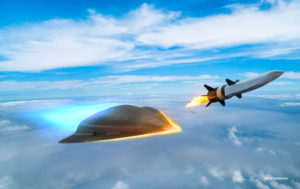The House Armed Services Strategic Forces Subcommittee mark for their portion of the FY 2021 defense authorization bill directs several missile defense oversight measures and a hypersonic missile program for Zumwalt-class destroyers.
The subcommittee mark to the FY ’21 National Defense Authorization Act (NDAA), released June 21, directs numerous measures to expand oversight on missile defense issues and explain the subcommittee’s priorities.

It keeps a close watch on the Next Generation Interceptor (NGI) program, which is replacing the canceled Redesigned Kill Vehicle (RKV) for the Ground-based Midcourse Defense system.
A provision requires Missile Defense Agency (MDA) Director Vice Adm. Jon Hill to notify the defense committees of any changes made to the NGI program within seven days. It also requires the Secretary of Defense to submit a report on NGI along with the MDA Director, Commander of U.S. Northern Command, and the Under Secretary of Defense for Policy.
The FY ’21 budget requested $4.9 billion to fund NGI development over the first five years (Defense Daily, Feb. 11).
The mark also addresses MDA efforts examine the utility of adding other missile defense systems for homeland usage until NGI is ready. In the administration’s FY ’21 budget request documents, DoD said it plans to assess whether the SM-3 Block IIA interceptors can defend against intercontinental ballistic missile threats and allocate funds for a Terminal High Altitude Area Defense (THAAD) homeland defense system.
One provision requires the Director of Cost Assessment and Program Evaluation (CAPE) to conduct an analysis of alternatives (AoA) for a complete architecture for using regional systems for homeland defense.
The study specifically would cover “sensors, testing, siting, manning, training, and sustainment of the entire architecture.”
The subcommittee language says it would require the AoA to prefer sites already previously assessed under an environmental impact analysis for a continental U.S.-based interceptor site, referring to the previously disclosed site at Fort Drum, N.Y., as a preferred location.
The analysis would also have an independent lifecycle cost estimate for the whole architecture and “should compare capabilities, costs and schedules with respect to using regional systems for homeland defense against deploying future ground-based midcourse defense systems.”
Another provision expresses the sense of Congress that the Missile Defense Agency (MDA) should be responsible for developing the sensor payload for the hypersonic and ballistic tracking space sensor (HBTSS). It would limit FY ’21 operations and maintenance funds for the Space Development Agency (SDA) to 50 percent until the Secretary of Defense provides a certification that MDA is responsible for the HBTSS sensor payload.
This comes after a March hearing wherein Rep. Mike Rogers (R-Ala.) pushed DoD officials to explain why funds for the HBTSS were moved from MDA to SDA in the FY ’21 budget request, given how MDA has received funds for the last several years to develop the system (Defense Daily March 16).
MDA Director Hill said SDA will provide funding to MDA to continue as the developer of the HBTSS sensor and then provide the final product to SDA.
Separately, one provision directs the Navy to start integrating a hypersonic missile onto the three Zumwalt-class guided-missile destroyers.

The section requires the Secretary of the Navy “to initiate integration efforts for the conventional prompt global strike program onto the DDG 1000-class destroyers not later than January 1, 2021.”
Zumwalt-class ships were originally planned to use their 155mm Advanced Gun System to support shore-based Marines at a range up to 80 nautical miles. In 2016, the Navy canceled the munition for the gun because it was too expensive once the ship class was cut from 28 to three. Then, in 2017, the Navy shifted the ship’s mission to offensive surface strike.
As the ships complete installation of all systems and are fully delivered, they are based in Surface Development Squadron One to experiment with new surface warfare capabilities along with medium and large unmanned surface vessels. The squadron was established last year (Defense Daily, May 24, 2019).
This draft mark section also requires the Chairman of the Joint Chiefs of Staff to submit a report to the congressional defense committees within 120 days of the act’s enactment covering operational control, policy concerns, escalation risk mitigation, and basing strategies for land-based variants of the conventional prompt global strike program.